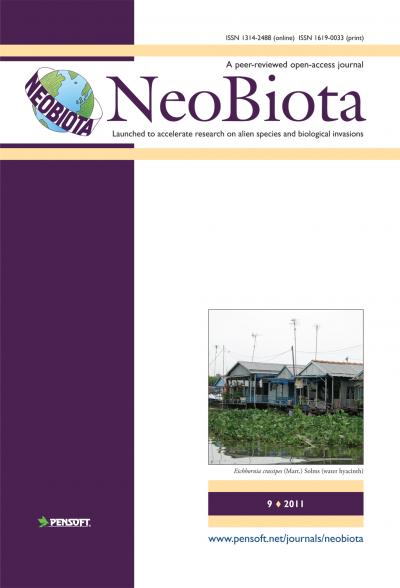Modelling the invasion dynamics of the African citrus psyllid: The role of human-mediated dispersal and urban and peri-urban citrus trees
IF 3
2区 环境科学与生态学
Q1 BIODIVERSITY CONSERVATION
引用次数: 3
Abstract
The African citrus psyllid, Trioza erytreae (Del Guercio) (Hemiptera, Triozidae), is native to tropical Africa and invasive species in North America and Europe. The main host plants are citrus, displaying a preference for lemon trees. This psyllid was recently detected in the northwest region of the Iberian Peninsula, both in Spain and Portugal. Here, we used a model combining a reaction-diffusion model to a stochastic long-distance dispersal model to simulate the invasion dynamics of T. erytreae in Portugal. The psyllid spread in Portugal was simulated between 2015 and 2021 for different combinations of model parameters: two fecundity levels; spread with and without stochastic long-distance dispersal; single or two introductions of T. erytreae; and considering or not the urban and peri-urban citrus trees, besides citrus orchards, estimated using Google Street view imagery. The incorporation of long-distance human mediated dispersal significantly improved the F1-score in the model validation using the official reports as the observed data. Concomitantly, the dispersal rate of T. erytreae in Portugal was on average about 66 km/year, whereas removing long-distance dispersal events, the observed mean was 7.8 ± 0.3 km/year. The dispersal was mainly towards the south along the coastline, where human population is concentrated. The inclusion of the estimated citrus trees outside orchards areas significantly increased the F1-score in the model validation, revealing the importance these isolated host plants hold as stepping stones for the species current invasion and possibly for other species alike.Modelling非洲柑橘木虱的入侵动态:人类介导的扩散和城市和城郊柑橘树的作用
非洲柑橘木虱Trioza erytreae(Del Guercio)(半翅目,木虱科)原产于热带非洲,是北美和欧洲的入侵物种。主要寄主植物是柑橘,表现出对柠檬树的偏好。这种木虱最近在西班牙和葡萄牙的伊比利亚半岛西北部地区被发现。在这里,我们使用了一个将反应扩散模型与随机远距离扩散模型相结合的模型来模拟厄立特里亚T.erytreae在葡萄牙的入侵动态。2015年至2021年间,针对不同的模型参数组合模拟了木虱在葡萄牙的传播:两个繁殖力水平;有无随机长距离扩散;一次或两次介绍的T.erytreae;以及是否考虑使用谷歌街景图像估计的城市和城郊柑橘树,以及柑橘园。在使用官方报告作为观察数据的模型验证中,引入远距离人类介导的扩散显著提高了F1分数。同时,厄立特里亚T.erytreae在葡萄牙的传播率平均约为66公里/年,而除去长距离传播事件,观察到的平均值为7.8±0.3公里/年。扩散主要是沿着海岸线向南,那里是人口集中的地方。包括果园外的估计柑橘树显著提高了模型验证中的F1分数,揭示了这些孤立的寄主植物作为物种当前入侵的垫脚石以及可能对其他物种的重要性。
本文章由计算机程序翻译,如有差异,请以英文原文为准。
求助全文
约1分钟内获得全文
求助全文
来源期刊

Neobiota
Agricultural and Biological Sciences-Ecology, Evolution, Behavior and Systematics
CiteScore
8.10
自引率
7.80%
发文量
0
审稿时长
6 weeks
期刊介绍:
NeoBiota is a peer-reviewed, open-access, rapid online journal launched to accelerate research on alien species and biological invasions: aquatic and terrestrial, animals, plants, fungi and micro-organisms.
The journal NeoBiota is a continuation of the former NEOBIOTA publication series; for volumes 1-8 see http://www.oekosys.tu-berlin.de/menue/neobiota
All articles are published immediately upon editorial approval. All published papers can be freely copied, downloaded, printed and distributed at no charge for the reader. Authors are thus encouraged to post the pdf files of published papers on their homepages or elsewhere to expedite distribution. There is no charge for color.
 求助内容:
求助内容: 应助结果提醒方式:
应助结果提醒方式:


